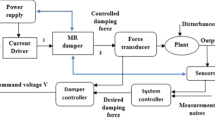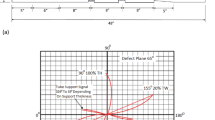Abstract
With the variance of preload and vibration in working conditions, wind turbine bolt loosening is difficult to predict accurately. To address the problem, wind turbine bolts are employed as the study object, and the loosening mechanism of bolts as well as the prediction of preload variation are investigated by means of finite element analysis. The result shows that, under the action of transverse vibration load, the magnitude of vibration load is the main factor affecting the loosening, and the larger the load magnitude, the more likely the loosening occurs. Besides, a bolt loosening prediction model based on Gaussian process regression is developed to obtain confidence intervals for the variation of the preload in a probabilistic sense. This study provides a theoretical basis for solving the problem of bolt loosening and preload relaxation in wind power under vibration conditions, and improves the safety and reliability of wind turbine operation.
Similar content being viewed by others
References
Y. Hu et al., Study on the loosening process of bolted connections under transverse load, J. of Vibration, Measurement and Diagnosis, 40(6) (2020) 1091–1098.
S. A. Nassar and B. A. Housari, Self-loosening of threaded fasteners due to cyclic transverse loads, ASME Pressure Vessels and Piping Conference, Denver (2005) 169–187.
X. Yang, S. A. Nassar and Z. Wu, Criterion for preventing self- loosening of preloaded cap screws under transverse cyclic excitation, J. of Vibration and Acoustics, 133(4) (2011) 041013.
S. A. Nassar and X. Yang, A mathematical model for vibration- induced loosening of preloaded threaded fasteners, J. of Vibration and Acoustics, 131(4) (2009) 1–13.
X. Yang and S. Nassar, Analytical and experimental investigation of self-loosening of preloaded cap screw fasteners, J. of Vibration and Acoustics, 133(3) (2011) 1–8.
A. M. Zaki, S. A. Nassar and X. Yang, Effect of conical angle and thread pitch on the self-loosening performance of preloaded countersunk-head bolts, J. of Pressure Vessel Technology, 134(2) (2012) 1–8.
G. H. Junker, Criteria for self loosening of fasteners under vibration, Aircraft Engineering and Aerospace Technology, 44(10) (1972) 14–16.
M. R. Wang et al., Anti-loosening test for vibration of composite bolted joints in high temperature environment, J. of Vibration, Measurement and Diagnosis, 38(6) (2018) 1169–1175.
Y. Q. Du et al., Research on self-loosening behavior of bolted joints under eccentric excitation, J. of Mechanical Engineering, 54(14) (2018) 74–81.
M. Zhang, L. Lu, W. Wang and D. Zeng, The roles of thread wear on self-loosening behavior of bolted joints under transverse cyclic loading, Wear, 394 (2018) 30–39.
M. Zhang, L. Lu, M. Tang and D. Zeng, Research on numerical calculation method of critical load for bolt loosening under transverse loading, J. of Mechanical Engineering, 54(5) (2018) 173–178.
H. Gong and J. Liu, Some factors affecting the loosening failure of bolted joints under vibration using finite element analysis, Proceedings of the Institution of Mechanical Engineers, Part C: J. of Mechanical Engineering Science, 232(21) (2018) 3942–3953.
H. Gong, J. Liu and X. Ding, Study on the mechanism and influencing factors of preload decline for bolted joints under vibration, J. of Mechanical Engineering, 55(11) (2020) 138–148.
H. Gong, J. Liu and X. Ding, Study on the mechanism of preload decrease of bolted joints subjected to transversal vibration loading, Proceedings of the Institution of Mechanical Engineers, Part B: J. of Engineering Manufacture, 233(12) (2019) 2320–2329.
H. Gong, J. Liu and X. Ding, Study on local slippage accumulation between thread contact surfaces and novel anti-loosening thread designs under transversal vibration, Tribology International, 153 (2021) 106558.
H. Gong, J. Liu and X. Ding, Thorough understanding on the mechanism of vibration-induced loosening of threaded fasteners based on modified Iwan model, J. of Sound and Vibration, 473 (2020) 115238.
J. Wu et al., A diagnostic approach for rotating machinery using multi-scale feature attention mechanism, J. of Xi’an Jiaotong University, 54(2) (2020) 51–58.
K. Ding et al., Digital twin-based multi-dimensional and multi-scale modeling of smart manufacturing spaces, Computer Integrated Manufacturing Systems, 25(6) (2019) 1491–1504.
S. Zhang et al., Research on double-driven model of blast furnace burden profile, Control Theory and Applications, 37(5) (2020) 978–986.
Z. Liang et al., Short-time wind speed forecasting based on gaussian process regression and particle filter, Acta Energiae Solaris Sinica, 41(3) (2020) 45–51.
G. Yu, Q. Zhiwen, R. Xiaomin, W. Ji-hui, Y. Ke and Lishuxin, Effects of defects on connection performance for wind turbine blades, Acta Energiae Solaris Sinica, 40(11) (2019) 3244–3249.
K. Long et al., Effects analysis of flange gap on bolt fatigue damage for wind turbine tower, Acta Energiae Solaris Sinica, 42(12) (2021) 206–211.
L. Wang et al., Prediction of bolt connection loosening based on mechanism and data fusion, Computer Integrated Manufacturing Systems, 27(3) (2021) 692–700.
Acknowledgments
This work is supported by the National Natural Science Foundation of China (No.51565030).
Author information
Authors and Affiliations
Corresponding author
Additional information
Hua Huang is a Professor at the School of Mechanical and Electrical Engineering in Lanzhou University of Technology. He obtained his Ph.D. from Tongji University, China, in 2011. His research interests include analysis and control of structural dynamics of mechanical equipment.
Yonghe Wang is a postgraduate student at the School of Mechanical and Electrical Engineering in Lanzhou University of Technology. His research interests include analysis and control of structural dynamics of mechanical equipment.
Rights and permissions
About this article
Cite this article
Huang, H., Wang, Y. & Pang, Q. Analysis and prediction of wind turbine bolts based on GPR method. J Mech Sci Technol 37, 1155–1164 (2023). https://doi.org/10.1007/s12206-023-0202-6
Received:
Revised:
Accepted:
Published:
Issue Date:
DOI: https://doi.org/10.1007/s12206-023-0202-6




